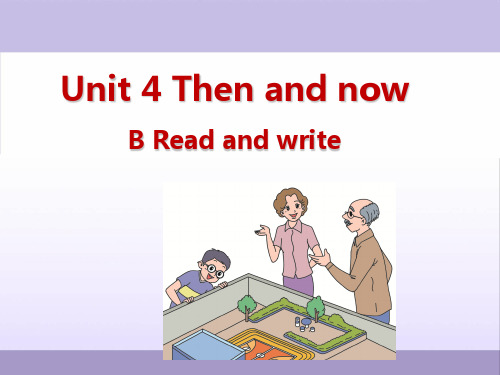2014 PEP 六年级U4 read and write
- 格式:ppt
- 大小:261.50 KB
- 文档页数:14



Unit4 B Read and write 教案教材:人教PEP小学英语六年级上册P42单元主题:I have a pen pal课型:读写课一、新授内容分析本课主要话题是通知公告。
通过有效引导,使学生能了解公告包含的几个要素,并能摘抄出相关重点句型,仿照范例个性化地编写自己的交友公告或社团广告。
二、教学流程说明1. 指导学生合作交流预习成果,检测朗读和相关任务完成情况,为进入课堂做好准备。
2. 层层渐进式引导,使学生了解公告书写结构格式,为进一步分析文本打下基础。
3. 帮助学生搭建语言,为进一步撰写公告打下基础。
4. 引导学生自由撰写公告,培养学生语言综合应用能力和敢于创新的思维。
三、教学过程Step1: Greeting and checking (导入检测)Activity1: Guessing gameT: Good morning, everyone.Ss: Good morning, Ivy.T: Well, do you want to know about me?Ss: Of course.T: OK, you can guess my personal information according to the numbers and words. S1: 3 —… your child is 3 years old.T: Oh, thanks for your answer. In fact, my daughter is nearly 3 years old.S2: There are 3 people in your family.T: Yes, you are right.S3: 1 — ... you are a good English teacher.T: Thank you! But not correct, 1 means first. This is my first time to come to Zhuhai.S4: 201 is your classroom’s name?T: Very good guessing. But not correct. I have 201 students, I love them so much.S5: English —… You ca n speak good English.T: Thanks a lot. You are right. My hobby is English. I usually join English corner. How did I know it? (停顿片刻)Because of the notice in WeChat. Is it fun?Ss: Yes!T: Do you want to join it?Ss: Yes, we do.T: OK, I will create an English corner in Ronghong School. So I should write a ... Ss: Notice!T: And I should put it on the …Ss: Notice board!T: Pretty good. Today let’s learn about notice together. (分别在黑板上贴单词磁条notice, board)【课堂说明:课堂气氛活跃,学生对老师抛出的数字和单词非常感兴趣,无论学生的表达是否正确,都在实现着老师的目标:口语操练】Activity2: CheckingT: Well, you have learned the four notices by yourselves yet, right? Now work in your group, read and discuss. If you have problems, raise your hands, I will help you.Are you clear?Ss: Clear!T: Take your time, go!(2分钟后)T: Now it’s show time, which group would like to have a try?Group1: We try.T: Please.(学生朗读完毕)T: Very good reading. Big hands for them. (师生鼓掌鼓励)Everyone, pay attention to these words, follow me. (学生跟读单词完毕)T: Other groups? Show your reading please.Group2: We try.T: Go ahead.(学生跟读完毕)T: Thank you very much. I do like your pronunciation. Big hands for you. (师生掌声鼓励)T: Well, if you want to read the passages very well. Pay attention to the stress. Look at me, weak tone(教师出示一个拳头),strong tone(教师同时出示两个拳头以手势引导学生理解重读和弱读的区别)T: All right, listen to me carefully. We can share. (老师边读边用手势强调重读和弱读) Would you like to have a try?S: Yes!T: Begin!S: Let’s read together.Science club, your club.Shall we dance? (学生边读,老师边做手势引导学生)T: Great! Let’s read the four not ices together, ready go!(学生朗读完毕)【课堂说明:检测朗读,根据每一组学生的朗读情况,老师先讲解重难点单词的发音,再示范重读和弱读的句型,最后带着学生通读全篇,帮助学生扫清语言障碍,为文本学习打下基础】T: Good job. Next, I will check your exercises, have a try!Pair1SA: Who write the notice?SB: Amy, John, Mike and Robin.T: Excellent! They are Amy, John, Mike and Robin.(教师在白板上划出答案,引导学生根据联系方式找出公告作者)T: The second one? You try.Pair2SA: What do they want to do?SB: They want to make friends.T: Very good answer! Do you have any other opinions?Ss: I think ... They want to share hobbies.T: Good job. They write notices for making friends and sharing hobbies.(教师在白板上划出正确答案)T: OK, next one. Which pair?Pair3SA: What are their hobbies?SB: Amy likes dancing. John likes playing football. Mike likes reading books. Robin likes making robots.T: Wonderful! We can also say Robin likes science, right?S: Yes!【课堂说明:通过检测预习任务完成情况,指导学生学会泛读和掌握获取关键信息的方法,最后带着问题进入新授学习中】Step2: Presentation&Practice【释疑指导环节】Activity1: Let’s readT: Well, the last question: Can you find out the same parts?S1: They both have E-mail and telephone number.(此处学生的表达略有问题,但老师并不刻意纠正)T: I agree with you. They all have E-mail and telephone number. We call them contact ways. (老师微微强调了all,暗示学生此处用all是正确的语法)S2: They have ... name.T: Great! They all have title.T: So a notice should have contact. (黑板上最下方贴出contact) And the contact may be phone number ...(教师边说变出示词卡,试图引导学生说)S: E-mail, QQ...T: Yes, QQ number. And...?S: ... (学生看到微信图片突然沉默)T: WeChat. You can read after me: WeChatS: WeChatT: And ...(贴出二维码词条) QR codeS: QR codeT: Are you clear? And a notice should have a title. Let’s read together, titleS: Title (贴出title词条)T: Read the four titles, OK?(学生边朗读,教师边将词条:Let’s ... /... club /Shall we ...? /...!!! 贴在title后面,为下一步学生取题做好铺垫)【课堂说明:课堂气氛活跃,学生在老师的引导下,不但了解了公告最基本的要素:联系方式和标题,还进一步了解了联系方式的多种类型和题目的多种风格】Activity2: Let’s thinkT: Well, let’s look at this notice. (白板出示第二篇公告Goal! Goal! Goal!)What’s the contact?S1: The contact is E-mail.T: Pretty good. Can you read it?S1: John@T: Wha t’s the title?S2: The title is Goal! Goal! Goal!T: Great! What does it mean? (手指标题) Look at the picture.Ss: The ball is flying in the net!T: Yes, the ball is kicked into the goal. The moment is so exciting. Let’s feel this moment, and read it like this: Goal! Goal! Goal!Ss: Goal! Goal! Goal!T: Wow, so exciting. Now, raise your hands, we are football fans. Goal! Goal! Goal! Ss: Goal! Goal! Goal!(教师通过演绎法,引导学生通过朗读题目,感知题目具有的吸引力)T: Great! Would you like to give it other titles?S1: Shall we play football?T: Wow, cool! I like this title, it’s very attractive! (将attractive词条贴到title一栏里) S2: Let’s play football!T: Good title! I do like this one.S3: Football club.T: Excellent! It’s very simple! (将simple词条贴到title一栏里)You are so smart!So we know a goo d title for a notice should be …Ss: simple and attractive.(教师通过让学生自由取题,引导学生感知公告题目须简明和具有吸引性)【课堂说明:老师运用深厚的语言功底,层层引导学生进一步了解标题的风格和特点,在细节中培养学生的语言思维能力。



人教PEP六年级上册英语《 Unit 4 Part B Read and write 》说课稿一. 教材分析《人教PEP六年级上册英语<Unit 4 Part B Read and write>》是一篇关于动物的文章。
文章描述了四种动物(猴子、熊猫、大象和狮子)的外貌特征和生活习性。
通过阅读这篇文章,学生可以进一步了解不同动物的特点,提高他们的阅读理解能力。
此部分还包括两个任务:Task 1要求学生根据图片和提示完成,Task 2要求学生根据文章内容完成练习。
二. 学情分析六年级的学生已经具备了一定的英语阅读能力,能够理解和表达简单的动物特征。
但在阅读长篇文章时,部分学生可能会遇到一些困难,如生词、长句等。
因此,在教学过程中,教师需要关注学生的个体差异,引导他们运用已学的阅读策略来解决问题。
三. 说教学目标1.知识目标:学生能够掌握文章中四种动物的外貌特征和生活习性,正确运用相关词汇和句型进行描述。
2.能力目标:学生能够独立阅读文章,理解文章内容,提高阅读理解能力。
3.情感目标:学生通过对动物的了解,培养关爱动物、保护环境的意识。
四. 说教学重难点1.重点:学生能够正确阅读和理解文章内容,掌握相关词汇和句型。
2.难点:学生能够运用已学的阅读策略,如预测、略读等,解决阅读过程中遇到的问题。
五. 说教学方法与手段1.任务型教学法:通过完成Task 1和Task 2,引导学生积极参与课堂活动,提高他们的阅读理解能力。
2.情境教学法:通过展示动物图片和视频,创设生动有趣的情境,激发学生的学习兴趣。
3.小组合作学习:学生分组进行讨论和交流,培养他们的合作意识和团队精神。
六. 说教学过程1.Pre-reading:教师展示四种动物的图片,引导学生进行预测,激发学生的阅读兴趣。
2.While-reading:学生独立阅读文章,回答教师提出的问题,引导学生关注文章细节。
3.Post-reading:学生分组进行讨论,完成Task 1和Task 2,教师给予指导和反馈。